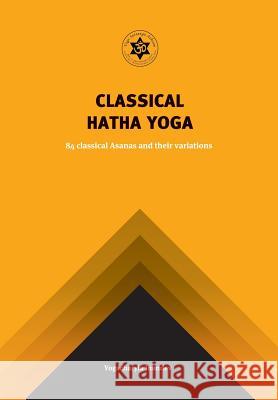Classical Hatha Yoga: 84 Classical Asanas and their variations » książka
Classical Hatha Yoga: 84 Classical Asanas and their variations
ISBN-13: 9780992784157 / Angielski / Miękka / 2016 / 282 str.
Asana: The Third Limb of Asht (eight) anga (limbs) Yoga Asana in modern yoga has become a synonym for Yoga. Most yoga followers are practising kriyas in the form of Suriya-namaskar or vinyasa and asana as a physical workout for many benefits like keeping fit, gaining flexibility, feeling good, being strong, looking attractive and enhancing vital energy. There is nothing wrong in that as we all need a healthy and strong body to begin. Swami Vivekananda states that, "all our immoral behaviour problems are rooted in weakness." To be free or to walk on a path to freedom and joy, we need to be very strong and healthy. In Shiva Samhita, Hatha Yoga Pradipika, Gheranda Samhita and other scriptures there is mention of 8,400,000 Asanas, which means form of births or life, YONI. We all have to go through each and every
life form to learn and experience to grow. Out of those they say only 84 are important. Out of those 84 only 32 are most important and out of those, 4 sitting postures are essential ones. To be successful in pranayama and meditation one needs to master one of them. This book attempts to describe these 84 important postures as they were taught to me (Yogachariya Jnandev / Surender Saini). According to Patanjali there are three steps to Asana. First is taking the position. The second is being aware to your position and the third is letting go of effort and relaxing to be comfortable. He describes Asana as 'sthiram sukham asanam 2.46' this means a 'STEADY, COMFORTABLE BODY POSTURE'. According to Patanjali and Hatha Yoga traditions practice of Asana and kriya should be slow, steady, and effortless with full awareness or attention. Our breath and mind should be merged with our practice. There should not be vigorous force, jerks and strains in your Hatha Yoga practice. This is the authentic was in which Yoga was taught and is still taught in older traditions.
Asana: The Third Limb of Asht (eight) anga (limbs) YogaAsana in modern yoga has become a synonym for Yoga. Most yoga followers are practising kriyas in the form of Suriya-namaskar or vinyasa and asana as a physical workout for many benefits like keeping fit, gaining flexibility, feeling good, being strong, looking attractive and enhancing vital energy. There is nothing wrong in that as we all need a healthy and strong body to begin. Swami Vivekananda states that, “all our immoral behaviour problems are rooted in weakness.” To be free or to walk on a path to freedom and joy, we need to be very strong and healthy.In Shiva Samhita, Hatha Yoga Pradipika, Gheranda Samhita and other scriptures there is mention of 8,400,000 Asanas, which means form of births or life, YONI. We all have to go through each and every
life form to learn and experience to grow. Out of those they say only 84 are important. Out of those 84 only 32 are most important and out of those, 4 sitting postures are essential ones. To be successful in pranayama and meditation one needs to master one of them. This book attempts to describe these 84 important postures as they were taught to me (Yogachariya Jnandev / Surender Saini).According to Patanjali there are three steps to Asana. First is taking the position. The second is being aware to your position and the third is letting go of effort and relaxing to be comfortable. He describes Asana as ‘sthiram sukham asanam 2.46’ this means a ‘STEADY, COMFORTABLE BODY POSTURE’.According to Patanjali and Hatha Yoga traditions practice of Asana and kriya should be slow, steady, and effortless with full awareness or attention. Our breath and mind should be merged with our practice. There should not be vigorous force, jerks and strains in your Hatha Yoga practice. This is the authentic was in which Yoga was taught and is still taught in older traditions.











